Div IV - Netsuke
Page 1 of 1
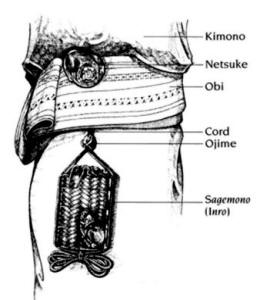 The
purpose of this section is to provide examples of Netsuke as defined in Div
IV, Section 7 in the NBS Classification Guide1
(Blue Book) including one or more examples that cover each term in the
definitions.
The
purpose of this section is to provide examples of Netsuke as defined in Div
IV, Section 7 in the NBS Classification Guide1
(Blue Book) including one or more examples that cover each term in the
definitions. A netsuke is small sculpture developed mainly by Japanese artists over the past several hundred years. Beyond its artistic nature, the Netsuke served an important functional purpose. The kimono, a traditional form of Japanese
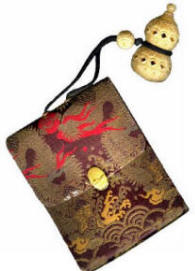 clothing,
had no pockets. Japanese women could carry small personal items in their
sleeves or in their obi (sash), but men needed some other form of "pocket"
to carry their personal items such as pipes, tobacco, purses or writing
implements. They met this need by storing personal items in a pouch called a
sagemono, which was hung using a silk cord from their obi. To secure the
cord from falling, a small toggle called a netsuke (pronounced net-ski) was
attached to the cord just above the obi. Often, a sliding bead called ojime
was strung on the cord between the netsuke and the sagemono to prevent items
in the sagemono from falling out.
clothing,
had no pockets. Japanese women could carry small personal items in their
sleeves or in their obi (sash), but men needed some other form of "pocket"
to carry their personal items such as pipes, tobacco, purses or writing
implements. They met this need by storing personal items in a pouch called a
sagemono, which was hung using a silk cord from their obi. To secure the
cord from falling, a small toggle called a netsuke (pronounced net-ski) was
attached to the cord just above the obi. Often, a sliding bead called ojime
was strung on the cord between the netsuke and the sagemono to prevent items
in the sagemono from falling out. All three objects, the netsuke, the ojime and the different types of sagemono were individually crafted, often with beautiful carving and finishes that included inlays, lacquer, and other material embellishments. The materials used included wood, ivory, bone, metals, shell and semi-precious stones. The wide range of subject matter included mammals, birds, reptiles, and people, including folklore heroes and villains and the mythical animals and immortals of Japanese legend. See the links at bottom of page for further information and study. Click on the image to the left to see more examples of netsuke/sagemono.
Blue Book class definitions focus on the various types of Netsuke. The major types are the Katabori - a figural sculpture netsuke that is the most common type, the Sashi - a long, thin netsuke, that was thrust through the belt from which the Sagemono suspended, the Manju - a netsuke named after a popular bean paste confection that came in a round, flat shape, the Ryusa - similar to the Manju netsuke but with an open work design, the Kagamibuta - (literally, "mirror lid") a special type of netsuke with a metal lid and a bowl, usually in wood or ivory, and the Mask - netsuke which are miniature versions of the masks used in Noh and Kyogen plays. The examples below show at least one example of each type with the vast majority of examples showing the most popular, Katabori. Several other design features are demonstrated in the images including specific materials, shapes, paint DF, pierced, carved, back marks, and brass OME.
| Hover your mouse over the netsuke images below to see the back of the netsuke | |||
|---|---|---|---|
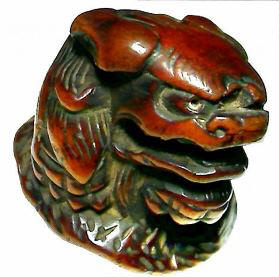 7-1 Katabori - Wood Metal Shank (1-1/2" x 1-3/8") |
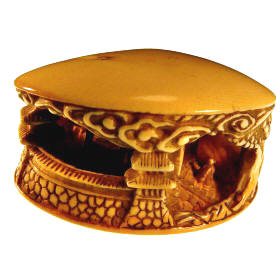 7-1 Anabori (Subset of Katabori) Hollow carved out center Often clamshell motif (1-1/2" x 1") |
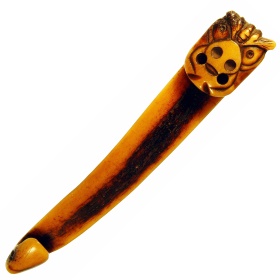 7-1 Sashi - Ivory (4") |
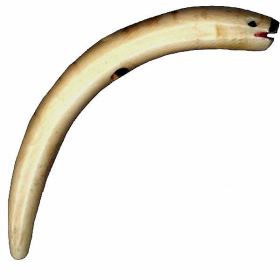 7-1 Sashi - Ivory (4") |
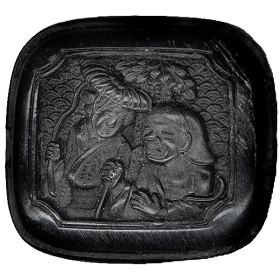 7-1 Manju - Horn Shape (1-1/2x1-3/8") |
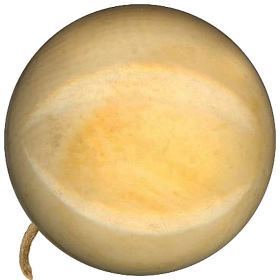 7-1 Manju - Ivory Two piece - Plain (1-1/2") |
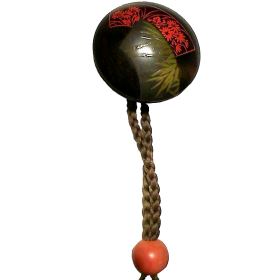 7-1 Manju - Wood Lacquer DF (1-1/2") |
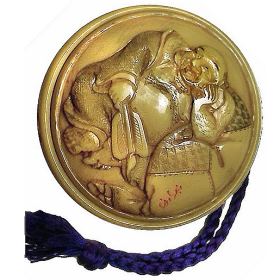 7-1 Manju - Ivory (1-7/8" - 5/8" Thick) |
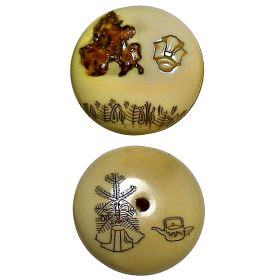 7-1 Manju - Ivory Lacquer DF (2") |
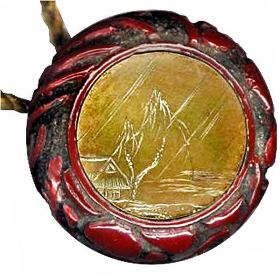 7-1 Manju - Wood Brass face - Lacquer DF (1-1/2") |
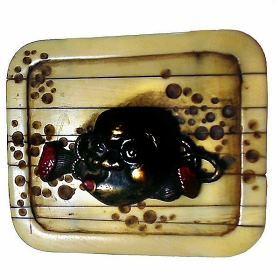 7-1 Manju - Bone Bronze OME (1-5/8 x 1-3/8") |
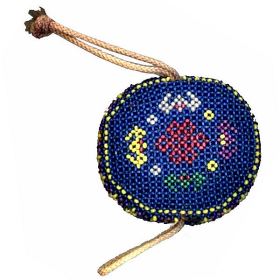 7-1 Manju - Beads (1-1/2") |
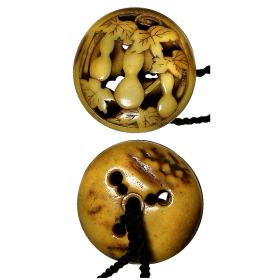 7-1 Ryusa - Bone Two Piece - Open Work (1-5/8") |
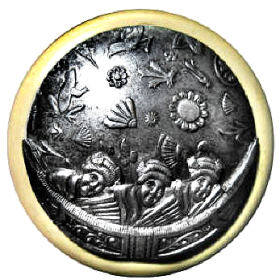 7-1 Kagamibuta - Celluloid & Silvered Brass Mikado 3 little maids (2") Click Here to See Parts |
.jpg) 7-1 Kagamibuta - Celluloid & Silvered Brass Mikado Katisha (1-1/2") |
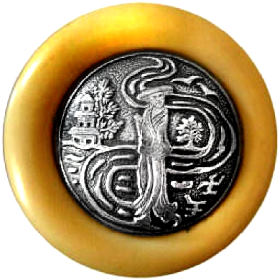 7-1 Kagamibuta - Ivory & Silvered Brass (1-1/2") |
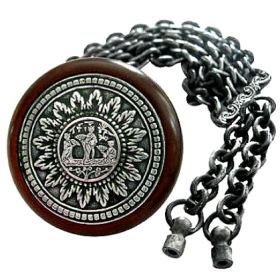 7-1 Kagamibuta - Clasp and Chain Mikado 3 little maids (1-3/4") |
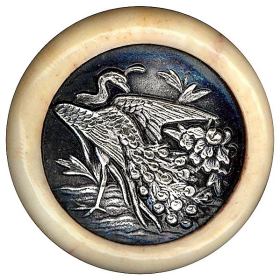 7-1 Kagamibuta - Ivory & Silvered Brass (1-1/8") |
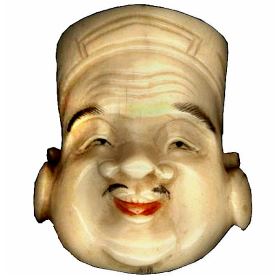 7-1 Mask - Bone (1-3/4") |
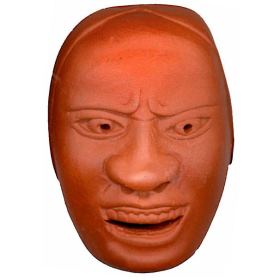 7-1 Mask - Ceramic Bisque (1-3/4") |
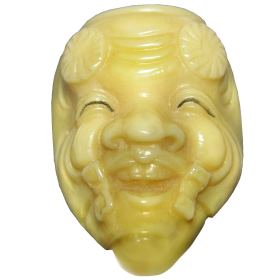 7-1 Mask - Plastic Back mark (1-1/4") |
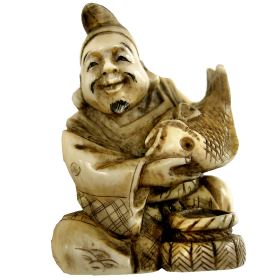 7-1 Katabori - Ivory (1-3/4" x 1-1/4") |
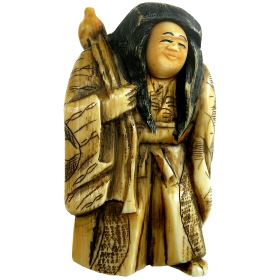 7-1 Katabori - Bone Moveable Face (2" x 1-1/8") |
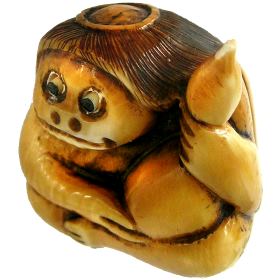 7-1 Bone Moveable Eyes (1-1/2" x 7/8") |
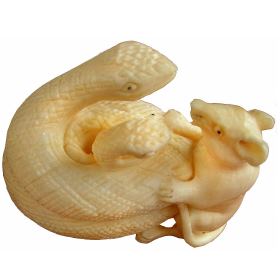 7-1 Katabori - Bone (1-1/2" x 1-1/4") |
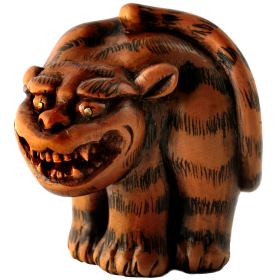 7-1 Katabori - Dyed Bone (2" x 2") |
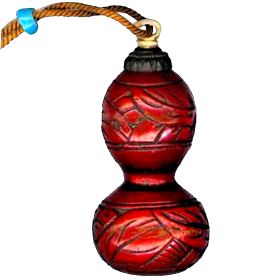 7-1 Katabori - Bone-Horn top Lacquered Wood (2") |
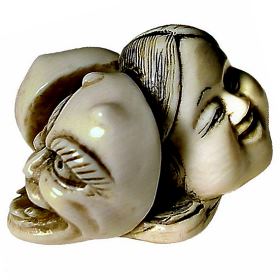 7-1 Katabori - Bone Five heads (1-1/2" x 1") |
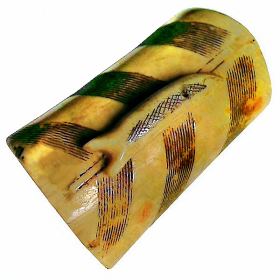 7-1 Katabori - Bone (1-3/4" x 1-1/8") |
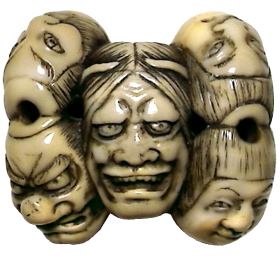 7-1 Katabori - Bone Seven heads (1-1/2" x 1-1/2") |
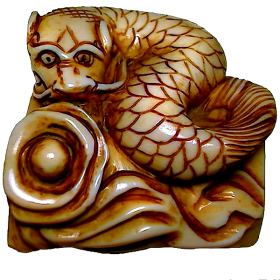 7-1 Katabori - Bone Catfish (2-1/4 x 2-1/4") |
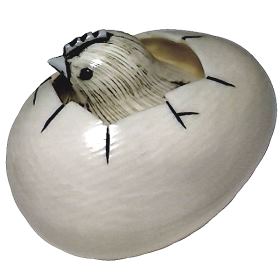 7-1 Katabori - Ivory (1-3/4" x 3/4") |
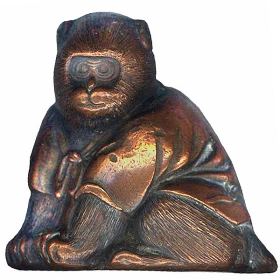 7-1 Katabori - Bronze (1-5/8") |
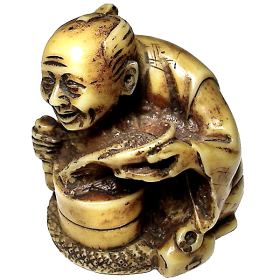 7-1 Katabori - Ivory (1-1/2" x 7/8") |
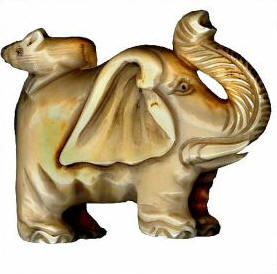 7-1 Katabori - Ivory (1-1/2") |
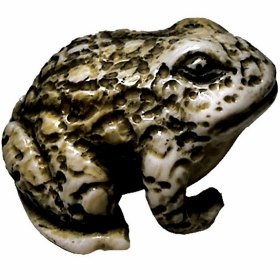 7-1 Katabori - Bone 1-5/8 x 1-1/4") |
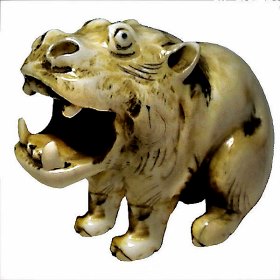 7-1 Katabori - Ivory (1-1/2" x 1") |
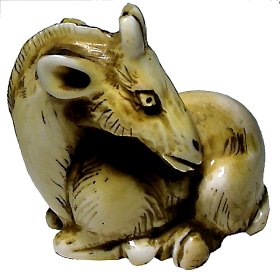 7-1 Katabori - Ivory (1-1/4" x 1") |
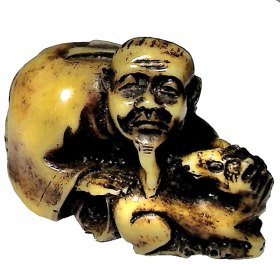 7-1 Katabori - Ivory (1-5/8 x 1-1/4") |
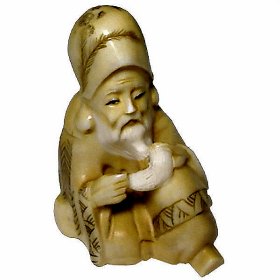 7-1 Katabori - Ivory (1-1/4 x 7/8") |
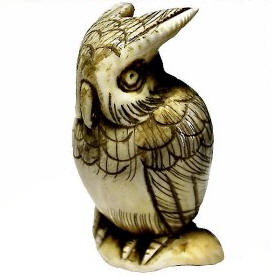 7-1 Katabori - Ivory (1-5/8 x 1-1/8") |
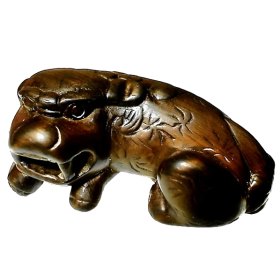 7-1 Katabori - Wood (2-1/2 x 1-1/4") |
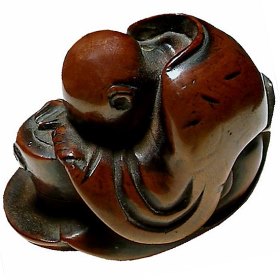 7-1 Katabori - Wood (1-3/4 x 1-1/4") |
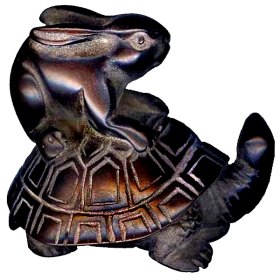 7-1 Katabori - Wood (1-3/4") |
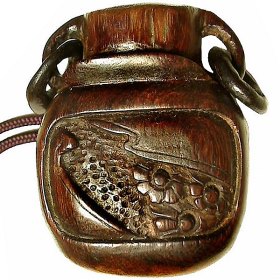 7-1 Katabori - Wood (1-1/4 x 7/8") |
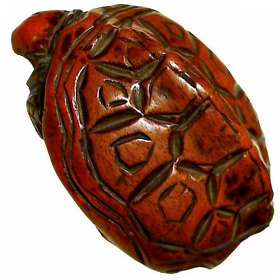 7-1 Katabori - Wood (1-1/4") |
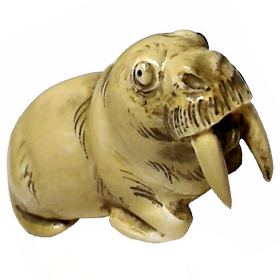 7-1 Katabori - Ivory (1-3/4" x 7/8") |
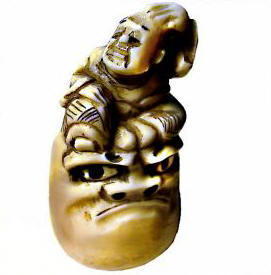 7-1 Katabori - Ivory (1-1/2" x 3/4") |
|
Acknowledgments: Thanks to the collaborators who made examples from their collections available for the images shown on this pages. They include Sally Gibson, Lou Yeargain, Bruce Cole, Marilyn Regrut and Gloria Farin. Others who contributed reviews, comments and support include Pat Fields, Pat Koehler, Jane Perry, Sarah Carroll, Barbara Barrans, and Ronnie Wexler. Potential labeling issues or suggested improvements should be directed to the Button Country team at Contact Us. References: (1) National Button Society Blue Book - Official NBS Classification and Competition Guidelines (2) International Netsuke Society website - http://www.netsuke.org/. (3) Netsuke Online Research Center - http://www.netsukeonline.org/htm/netsuke101.html (4) Kyoto Seishu Netsuke Art Museum - http://www.netsukekan.jp/english/index.html (5) Weird Asia News webpage on Netsuke - http://www.weirdasianews.com/japanese-netsuke/ (6) Bolton Museum and Archive Services -http://www.boltonmuseums.org.uk/collections/art/decorative/netsuke/ (7) Koryuen - Site for More Appreciation of Netsuke - http://www.cc.rim.or.jp/~komada/ (8) Wikipedia Netsuke Page - http://en.wikipedia.org/wiki/Netsuke (9) Aichele, Frieder and Gert Nagel. Netsuke, trans. Catherine Hutter. New York: Popular Library, 1977 Note to the Viewer: A number of the examples shown are modern replicas that were made primarily for display rather than as a functional toggle. Several suffer in the quality of their craftsmanship and artistic design as compared to the older netsuke made for their intended use. As a result, some serious netsuke collectors will consider several of these examples less than "true netsuke." |
|||